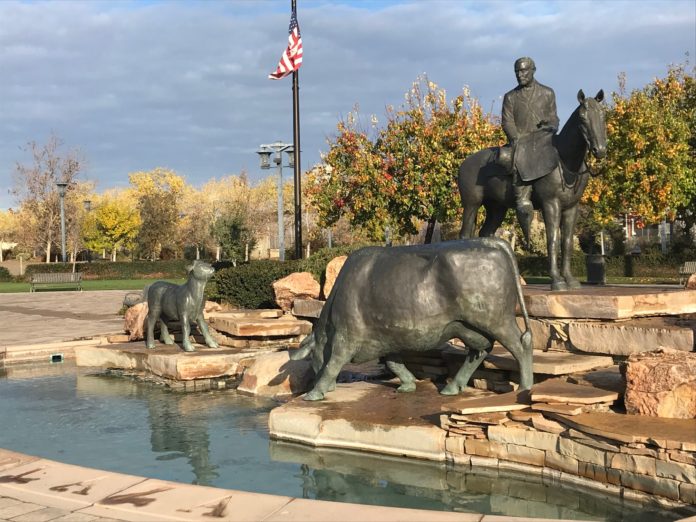The San Luis Delta Mendota Water Authority held its board of directors meeting on Thursday, April 4, 2024 at its Los Banos headquarters and on Zoom. Before we get started with this meeting, I want to remind you of two or three things. According to www.holidayscalendar.com today is not only burrito day, it’s also carrot day. There’s a lot of other days listed too. Today is Liar’s Day, a day for telling tall tales and somewhat redundantly/ironically today is also Hug a Newsperson Day – where for some reason we’re supposed to grab hold a reporter and squeeze them. Although it wasn’t implicitly stated not to use a pair of pliers when squeezing I know some journalist who might tempt the act. Come to think of it my wife might even be married to one, so let’s not do that.
redundantly/ironically today is also Hug a Newsperson Day – where for some reason we’re supposed to grab hold a reporter and squeeze them. Although it wasn’t implicitly stated not to use a pair of pliers when squeezing I know some journalist who might tempt the act. Come to think of it my wife might even be married to one, so let’s not do that.
A week from Saturday on the 13th of April the Punjabi American Growers Group will be hosting an ag workshop day in Madera, full of vendors, panel discussions and an opportunity to learn more about many things impacting the ag industry in California. Duarte Nursery will be hosting its Friends Day on May 3rd at its headquarters near Modesto. This is a combination farm show/banquet and a fun day to see what’s happening on the north side of the San Joaquin Valley.
The State Water Resources Control Board will be holding a meeting on April 16th in Sacramento to determine if the Tulare Lake Subbasin will be placed on probation under SGMA. The State Board staff is recommending probation, Non-Government Organizations like the Community Water Center are publicly calling for probation. Originally the per acre foot fine was $40 for pumping. Combined with other mandated costs this would have immediately sucked $30 million from the local ag economy. The money would be given to the State Board to pay for its staff managing the subbasin’s groundwater. The optics of Hoovering $30 million and giving it to an unelected agency during an election year was a bit much. The $40 dollar per acre foot fine has been cut in half to $20. That means only $20 million will be owed. And is it even possible the per month late fee is really 25-percent, per month?
SGMA. The State Board staff is recommending probation, Non-Government Organizations like the Community Water Center are publicly calling for probation. Originally the per acre foot fine was $40 for pumping. Combined with other mandated costs this would have immediately sucked $30 million from the local ag economy. The money would be given to the State Board to pay for its staff managing the subbasin’s groundwater. The optics of Hoovering $30 million and giving it to an unelected agency during an election year was a bit much. The $40 dollar per acre foot fine has been cut in half to $20. That means only $20 million will be owed. And is it even possible the per month late fee is really 25-percent, per month?
It is interesting to note board member Laurel Firestone, is a founder of the Community Water Center. I don’t think either the CWC or Firestone holds sway over the other. But the NGOs are claiming probation is needed to protect the domestic wells of Disadvantaged Communities or DACs. Most of the folks living in DACs are Hispanic. The San Joaquin Valley is estimated to be 80-percent Hispanic. Agriculture is the biggest economic engine in the Valley. Who’s really going to be hurt the most by this fine? The big, bad farmer or the helpless DAC lambs? Or the tractor parts salesman? Or the poor guy who’s just trying to make his auto detail business work?
The five-member Governor appointed board will make the decision, not staff, not NGOs and not you. It’s not an easy seat to sit. The board members are aware of the impacts this decision will have. Not to drop names but Secretary of Natural Resources Wade Crowfoot once told me something like this, “When the teachers’ union finds out they’re getting 13.54 instead of the 15.97 percent raise they requested they garb themselves in matching t-shirts and swarm the capital by the hundreds. When something with big impacts on ag takes place one or two farmers show up. Maybe.”
The Meeting
Chairman Cannon Michael called the meeting at 9:30am on the dot. Things began with a salute to the flag of the greatest nation on earth. This was followed by a rapid fire self-introduction. I saw a couple of empty chairs along the wall. Something I’ve never seen before at that meeting. And as suddenly as it started, poof the meeting went into closed session at 9:34am. And at 10:09am the sound came back on. Attorney Becca Akroyd said the board discussed an agreement with the Friant Water Authority over some intertie pumping costs which were found agreeable. I think.
Consent Calendar & Action Items
The consent calendar was passed without comment and Pablo Arroyave told the board about a proposed contract between the US Bureau of Reclamation and San Luis Delta Mendota to pay for the extraordinary maintenance costs on the Jones Pumping Plant. The board approved a resolution in accordance with the finance committee recommendations.
The East West Divide Gets Closer
The next item was taken up by CEO Federico Barajas about the agreement with the Friant Water Authority. Along with the USBR, Friant and SLDM have reached an agreement on a Memorandum of Understanding about allocation, collection and payment of Operations, Maintenance & Repair costs.
Akroyd got into the details. The MOU was originally created in 1982 back when Friant was the Friant Water Users Authority. She said the substantive change was in the cost allocation and cost recovery portion. This will give Friant a voting right on OM&R matters impacting them. Friant will also have a seat on the cost allocation committee. There will be more flexibility on resolving disputes and the Bureau could be brought in to help. The MOU includes six cost pools to determine who pays what to who.
The reason Friant wants a say so is it pays for much of SLDM’s expenses in exchange for access to San Joaquin River water diversions to the Friant Kern Canal. A large part of the original riparian water rights for the San Joaquin River were held by the Miller & Lux Ranch and other landholdings on the Valley’s westside.
Akroyd said if the board adopts the resolution to enter into this MOU there will be a 60-day review of the cost recovery plan. There was some discussion and I think I could recognize the director’s voice but couldn’t understand what was said exactly. I think there was praise for staff and Akroyd for the hard work of wrestling with the redlined versions of a decades old document. The board approved.
Michael said much of the same things Friant’s CEO Jason Phillips said at last week’s FWA meeting. Not everyone is happy with this agreement and it was contentious in reaching it, but it had to be done. He thanked Friant’s Wilson Orvis and all the staff from both sides.
USBR Commissioner Camile Touton was present at the meeting and Barajas said it was her fault things worked out so well and thanked her. He also said he appreciated Orvis and Phillips and the Friant team.
Next J. Scott Petersen reported to the board the finance committee recommends the board adopt a resolution dealing with the indirect cost rate policy for scientific activities. This involves the University of California requiring SLDM to adopt its cost rates. He said this will enable more work to get done at a lower cost. That was an easy sell.
The last action item was also given by Petersen about adopting positions on legislation. He recommended: a support with amendment on S3830 by Senator Alex Padilla to help with low income households’ water costs. He listed a couple of the proposed amendments. On the state side the upcoming bills were mostly helpful as opposed to mostly harmful. There are those kinds of bills out there too and Petersen has a knack for spotting, following and coming up with game plans to deal with them. The board adopted his recommended positions and Michael thanked him for the heavy lift of keeping track of things.
Report Items
Michael introduced Touton and said she has an extra special gift of understanding and working with the folks from the west. Barajas thanked her for taking time to be with them in Los Banos. She is busy and Barajas acknowledged that.
Touton spoke saying the Bureau and SLDM have worked closely and well together. She said water allocations are top of mind for not only growers but also the Bureau. Most of California is at or above average for this year’s hydrology. She committed to be transparent about how the allocation decisions are made. She also said the MOU with Friant is impressive and the time spent, although there was a lot of time spent, will yield great results. She said the agreement is critical to the Bureau being able to better deploy resources to the Central Valley Project.
Touton said the Bureau is working with Congress and the California Department of Transportation on the BF Sisk Dam raise. There are five small storage projects on the table with four of them in California; such as the Del Puerto Canyon Reservoir project. She will be at the pumps near Tracy later today to meet with Governor Gavin Newsom and Congressmen Jim Costa and Jared Huffman. She feels this shows the state and federal governments’ commitments to the San Joaquin Valley.
Transportation on the BF Sisk Dam raise. There are five small storage projects on the table with four of them in California; such as the Del Puerto Canyon Reservoir project. She will be at the pumps near Tracy later today to meet with Governor Gavin Newsom and Congressmen Jim Costa and Jared Huffman. She feels this shows the state and federal governments’ commitments to the San Joaquin Valley.
Touton said she’s proud of the Bureau’s history of helping feed the nation and the world. She said most Bureau employees live in the areas they serve and have to face their neighbors in places of worship, their children’s schools and the grocery store. Amen sister.
Michael pointed out the innovation of SLDM, growers, wildlife and Silicon Valley are all represented on the board. He said that merges well with the Bureau’s innovation. The new Bureau’s regional director Karl Stark attended the SLDM last month and many of the directors voiced their appreciation of having Bureau decision makers interact with them.
Gov’t Mischief
From the administrative to the legislative branch SLDM covers it in their meetings. Petersen said the Biden Administration has revised critical habitat and endangered species regulations under the ESA. If I understand it rolls back the progress made under the Trump Administration to standards and policies under the Obama Administration. Kind of what happened with the Biological Opinions that took place on the Delta matters. There are ongoing biops. The Trinty River consultations should shed some light on the Sacramento River operations by the end of the year.
happened with the Biological Opinions that took place on the Delta matters. There are ongoing biops. The Trinty River consultations should shed some light on the Sacramento River operations by the end of the year.
Petersen said the Monarch Butterfly status and one other species that isn’t actually endangered but might be if the climate changes in the future are both items of concern.
Petersen spoke about how most of the funding for infrastructure is moving about the same. He also said congress is going through budget talk and the water resources development bills.
On the state side Petersen said the state budget is bad and worse than reported. There is a budget deficit package proposed in Sacramento that doesn’t include safeguards for water or ag at this time. That most likely means if there are cuts in these areas of concern they will take place later. There is a water quality workshop coming up later in the month. He called it exciting but I think that’s a euphemism for something else.
Kristin Olsen reported from Sacramento that the legislature just came back from Easter break and hasn’t had enough time yet to really screw things up. My words not hers. There are estimates that the if the government cuts $17 billion from the budget the deficit will only be between $9 billion and $20 billion.
CEO Report
Barajas told the board there is a big list of items in the packet about the incredible progress made between SLDM and Friant. There is a South of Delta Drought Plan and a pilot project is now onboard with the signing of the MOU. There’s 82,000 a/f in San Luis Reservoir that can be contributed to the project. The goal is to incorporate lessons learned from this year’s management of the program. There has to be a proactive drought plan during wet years.
is now onboard with the signing of the MOU. There’s 82,000 a/f in San Luis Reservoir that can be contributed to the project. The goal is to incorporate lessons learned from this year’s management of the program. There has to be a proactive drought plan during wet years.
Barajas said two letters were submitted by SLDM to the Bureau concerning pay back of costs charged against the SLDM. He said the O’Neil Forebay pump status has changed. Arroyave said the transformer rehabilitation project was delayed for a few months because the projected reduced pumping at the Jones Plant would place increased demands on SLR. This work is an urgent priority for the system and repairs will most likely take place in August.
This work is an urgent priority for the system and repairs will most likely take place in August.
Becca reminded the elected officials they have to take two-hours of ethics training. There are sessions coming up in person and online. Michaels said the naughty list won’t be released unless a director fails to take training. If a director has already had this training at the home board that will suffice.
Barajas will be bringing the management team together to focus on the long-term strategic plan implementation. He said there will be an intense workshop. There is an advent at the O’Neil Forebay with the Governor and others there will be security procedures in place so let Petersen know if you’re going but have yet to sign up.
COO & Water Report
Arroyave said there will be staggered outage at the Jones Plant to be aware of. There will not be a north to south transfer this year primarily due to lack of conveyance ability.
Tom Patton from the Central Valley Coordination office reported a 99-percent year in the north part of the state, so almost normal. The further south the less but still in the 80s percent. Snowpack peaks at April 1st and looks good. The Trinity Reservoir will reach more than two million a/f soon. He expects a 700,000 a/f release to the Sacramento River will soon be announced. Shasta Reservoir is still rising. Folsom is rising. Both are releasing flood clearance flows. New Mellones on the Stanislaus is releasing pulse flows. The federal side of San Luis filled up in March but releases are slowly reducing this storage. Jones is running one pump currently. He said Whisky Town Reservoir is about half full and rising.
Barajas added he expects a call made next week on this being an above normal water year. He’s looking for that on April 9th. He said SLDM is looking at a day to day operation between now and then. He said once that determination is made expect things to change.
Other Reports
If there were any committee reports I didn’t hear them. Outside agency reports started with Mike Wade of the California Farm Water Coalition who said there are now conference calls available for everyone to listen and learn from. There are new information fact sheets printed up. We are consuming more water in our food than most anyone would expect. They took a menu from the USDA and estimated 810 gallons of water in the food production daily. By 2044 California will need an additional million a/f to raise enough food to feed everyone. How about that?
production daily. By 2044 California will need an additional million a/f to raise enough food to feed everyone. How about that?
Director John Varela reported the May ACWA conference is coming up soon. He said there is new trustee on the ACWA Foundation board – Westlands Water District’s General Manager Allison Febbo is now officially on the board. He said Febbo’s addition to the great work already being done by other board members such as Dr. Steve Blumenshine from the CSU WATER having Feebo will strengthen the ACWA Foundation’s Central Valley presence.
Petersen reported on the Water Blueprint for the San Joaquin Valley is developing an ad hoc steering committee. Contribution appeals will be soon landing in mailboxes and if you have any questions call him. In related news the Collaborative Action Plan has been requested to help with identifying water employment opportunities. There is also some federal grant money heading towards CAP and that will help.
Director Anthea Hansen reported on the Central Valley Water Association saying there is more focus on energy’s interaction with water.
Director Bill Diedrich spoke up saying he’s held his tongue but in light of a normal water year the 35-percent allocation is hard to handle. He said the economy is in a position where the small family farm is hurting. The pressure from all the regulation is forcing some family farms to have to see as they can’t keep up with the costs when they can’t get the water. He urged Touton and others to understand the situation. Diedrich isn’t a whiner so you’d best listen up. He said another couple of years of this and that might be the edge to put them out of business. He’s a fourth generation family farmer and he wants his children to be fifth generation.
Touton said she’s not a farmer but benefits from the bounty. She said the Bureau is trying to get as much water as it can to growers. She recognizes there’s the time between now and the harvest and they will be working together.
Chris White said the Bureau and the CVP have the best operators you can get but they are battling excessive regulations when it comes to getting water to growers.
It was announced San Benito County Water Agency is looking for a new GM.
Michael said he backs Diedrich’s comments. He said banks are becoming much more stringent in lending based on water. He said the system is sick, if I heard him correctly. With the amount of water this year a 35 percent allocation isn’t right. Director Ross Fransen of Westlands said they added hundreds of thousands of acre feet to recharge and now they are having to pump. James ID GM Manny Amorelli said his growers are asking what’s happening. They paid off the WINN contract and wonder why if it didn’t give the Bureau what was needed to get good allocations out early enough to help. He said his district is surrounded by DACs and they need the growers to grow to support themselves financially.
district is surrounded by DACs and they need the growers to grow to support themselves financially.
The meeting was adjourned at 11:58am. Folks were going across the street to the Wool Growers Restaurant and then out to San Luis Reservoir. I suggest the rest of us go out into the world and be good to each other and ourselves.
DISCLAIMER OF RESPONSIBILITY; Waterwrights strives to provide his clients with the most complete, up-to-date, and accurate information available. Nevertheless, Waterwrights does not serve as a guarantor of the accuracy or completeness of the information provided, and specifically disclaims any and all responsibility for information that is not accurate, up-to-date, or complete. Waterwrights’ clients therefore rely on the accuracy, completeness and timeliness of information from DAW entirely at their own risk. The opinions expressed in this report are those of the author and do not represent any advertisers or third parties.
ALL RIGHTS RESERVED. Copyright 2024 by Don A. Wright
SAN LUIS & DELTA-MENDOTA WATER AUTHORITY was established in January of 1992 and consists of approximately 2,100,000 acres of 29 federal and exchange water service contractors within the western San Joaquin Valley, San Benito and Santa Clara counties. The governing body of the Authority consists of a 19-member Board of Directors classified into five divisions with directors selected from within each division. The main conveyance is the Delta-Mendota Canal that delivers approximately 3,000,000-acre feet of water within the Authority service area. Of this amount, 2,500,000-acre feet are delivered to highly productive agricultural lands, 150,000 to 200,000-acre feet for municipal and industrial uses, and between 250,000 to 300,000 acre-feet are delivered to wildlife refuges for habitat enhancement and restoration.
Board – Chairman: Cannon Michael,
Staff – Executive Director: Federico Barajas, COO: Pablo Arroyave, Attorney: Becca Akroyd, Director Finance: Ray Tarka, Director Water Policy: J. Scott Petersen, Director O&M/Facilities: Bob Martin
Email: youtellus@sldmwa.org 209/826-9696
P.O. Box 2157 Los Banos, CA. 93635
































